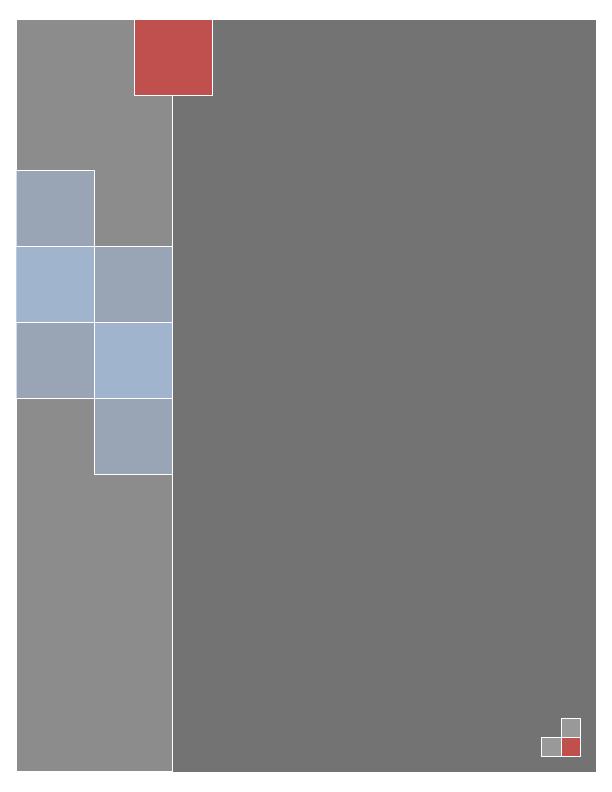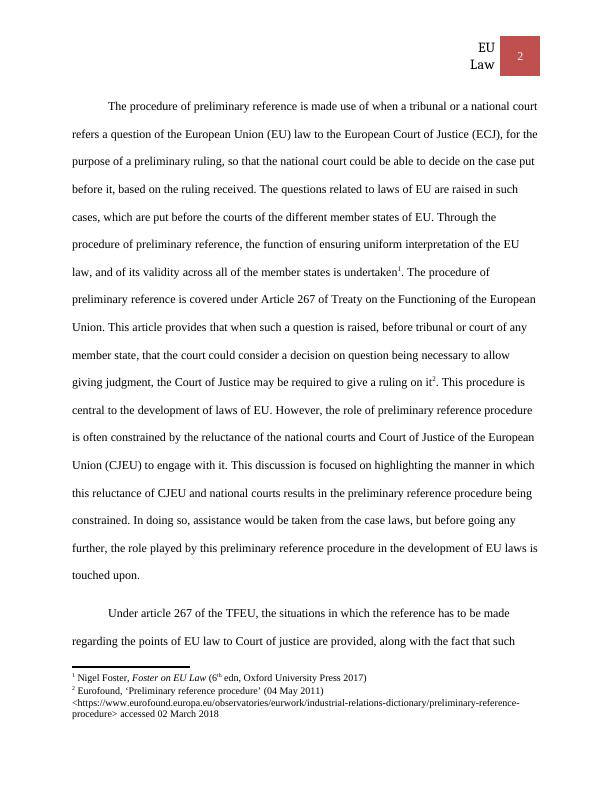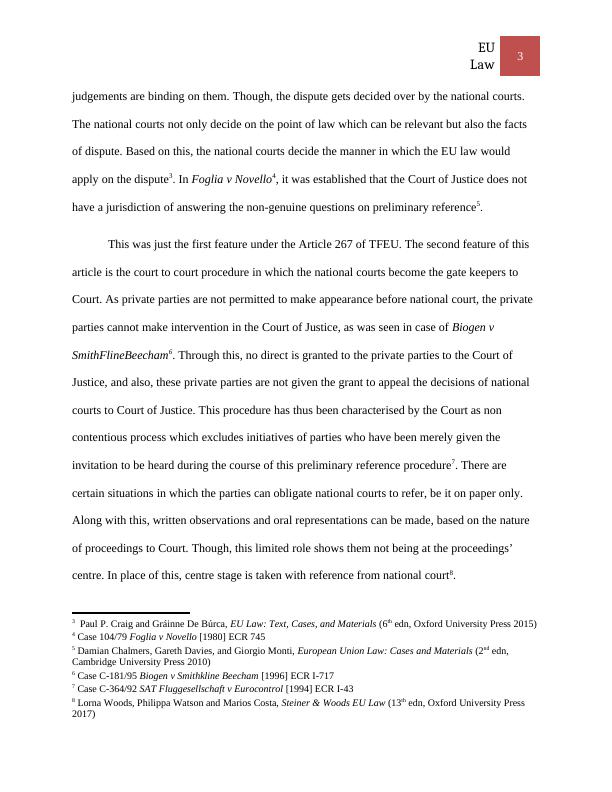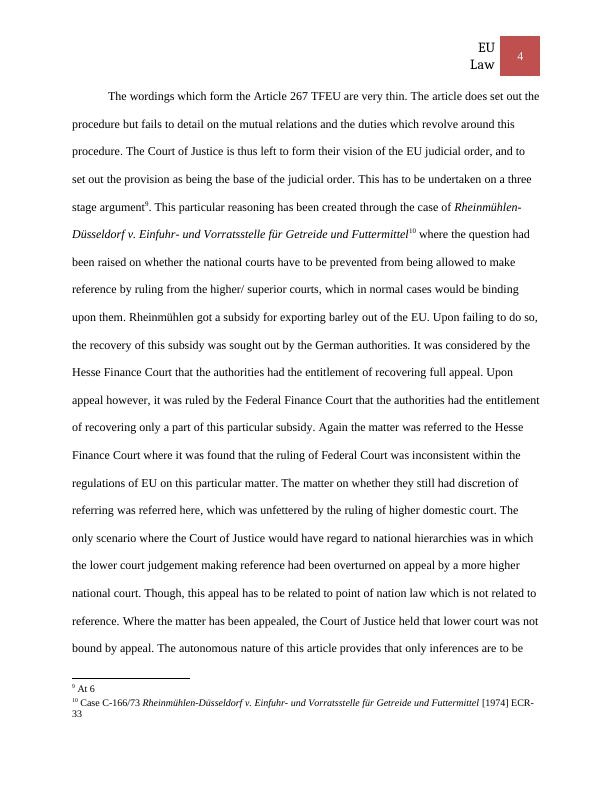European Union (EU) law : Assignment
13 Pages3332 Words34 Views
Added on 2021-04-21
European Union (EU) law : Assignment
Added on 2021-04-21
ShareRelated Documents

EULaw2The procedure of preliminary reference is made use of when a tribunal or a national courtrefers a question of the European Union (EU) law to the European Court of Justice (ECJ), for thepurpose of a preliminary ruling, so that the national court could be able to decide on the case put before it, based on the ruling received. The questions related to laws of EU are raised in such cases, which are put before the courts of the different member states of EU. Through the procedure of preliminary reference, the function of ensuring uniform interpretation of the EU law, and of its validity across all of the member states is undertaken1. The procedure of preliminary reference is covered under Article 267 of Treaty on the Functioning of the European Union. This article provides that when such a question is raised, before tribunal or court of any member state, that the court could consider a decision on question being necessary to allow giving judgment, the Court of Justice may be required to give a ruling on it2. This procedure is central to the development of laws of EU. However, the role of preliminary reference procedure is often constrained by the reluctance of the national courts and Court of Justice of the European Union (CJEU) to engage with it. This discussion is focused on highlighting the manner in which this reluctance of CJEU and national courts results in the preliminary reference procedure being constrained. In doing so, assistance would be taken from the case laws, but before going any further, the role played by this preliminary reference procedure in the development of EU laws istouched upon. Under article 267 of the TFEU, the situations in which the reference has to be made regarding the points of EU law to Court of justice are provided, along with the fact that such 1 Nigel Foster, Foster on EU Law (6th edn, Oxford University Press 2017)2Eurofound, ‘Preliminary reference procedure’ (04 May 2011) <https://www.eurofound.europa.eu/observatories/eurwork/industrial-relations-dictionary/preliminary-reference-procedure> accessed 02 March 2018

EULaw3judgements are binding on them. Though, the dispute gets decided over by the national courts. The national courts not only decide on the point of law which can be relevant but also the facts of dispute. Based on this, the national courts decide the manner in which the EU law would apply on the dispute3. In Foglia v Novello4, it was established that the Court of Justice does not have a jurisdiction of answering the non-genuine questions on preliminary reference5. This was just the first feature under the Article 267 of TFEU. The second feature of this article is the court to court procedure in which the national courts become the gate keepers to Court. As private parties are not permitted to make appearance before national court, the private parties cannot make intervention in the Court of Justice, as was seen in case of Biogen v SmithFlineBeecham6. Through this, no direct is granted to the private parties to the Court of Justice, and also, these private parties are not given the grant to appeal the decisions of national courts to Court of Justice. This procedure has thus been characterised by the Court as non contentious process which excludes initiatives of parties who have been merely given the invitation to be heard during the course of this preliminary reference procedure7. There are certain situations in which the parties can obligate national courts to refer, be it on paper only. Along with this, written observations and oral representations can be made, based on the nature of proceedings to Court. Though, this limited role shows them not being at the proceedings’ centre. In place of this, centre stage is taken with reference from national court8. 3 Paul P. Craig and Gráinne De Búrca, EU Law: Text, Cases, and Materials (6th edn, Oxford University Press 2015)4Case 104/79 Foglia v Novello [1980] ECR 7455 Damian Chalmers, Gareth Davies, and Giorgio Monti, European Union Law: Cases and Materials (2nd edn, Cambridge University Press 2010)6 Case C-181/95 Biogen v Smithkline Beecham [1996] ECR I-7177 Case C-364/92 SATFluggesellschaft v Eurocontrol [1994] ECR I-438 Lorna Woods, Philippa Watson and Marios Costa, Steiner & Woods EU Law (13th edn, Oxford University Press 2017)

EULaw4The wordings which form the Article 267 TFEU are very thin. The article does set out theprocedure but fails to detail on the mutual relations and the duties which revolve around this procedure. The Court of Justice is thus left to form their vision of the EU judicial order, and to set out the provision as being the base of the judicial order. This has to be undertaken on a three stage argument9. This particular reasoning has been created through the case of Rheinmühlen-Düsseldorf v. Einfuhr- und Vorratsstelle für Getreide und Futtermittel10 where the question had been raised on whether the national courts have to be prevented from being allowed to make reference by ruling from the higher/ superior courts, which in normal cases would be binding upon them. Rheinmühlen got a subsidy for exporting barley out of the EU. Upon failing to do so,the recovery of this subsidy was sought out by the German authorities. It was considered by the Hesse Finance Court that the authorities had the entitlement of recovering full appeal. Upon appeal however, it was ruled by the Federal Finance Court that the authorities had the entitlementof recovering only a part of this particular subsidy. Again the matter was referred to the Hesse Finance Court where it was found that the ruling of Federal Court was inconsistent within the regulations of EU on this particular matter. The matter on whether they still had discretion of referring was referred here, which was unfettered by the ruling of higher domestic court. The only scenario where the Court of Justice would have regard to national hierarchies was in which the lower court judgement making reference had been overturned on appeal by a more higher national court. Though, this appeal has to be related to point of nation law which is not related to reference. Where the matter has been appealed, the Court of Justice held that lower court was notbound by appeal. The autonomous nature of this article provides that only inferences are to be 9At 610 Case C-166/73 Rheinmühlen-Düsseldorf v. Einfuhr- und Vorratsstelle für Getreide und Futtermittel [1974] ECR-33

End of preview
Want to access all the pages? Upload your documents or become a member.
Related Documents
Understanding Article 267 TFEU in European Union Lawlg...
|7
|1604
|96
Article 267 TFEU - Treaty On The Functioning Of The European Unionlg...
|16
|3653
|690
Supremacy and Direct Effects Contributions to the Achievement of CJEUlg...
|9
|2285
|245
Sources of European Union Law and Restrictionslg...
|11
|3847
|50
Main sources of European Union (EU) Lawlg...
|11
|2432
|500
Main Sources of European Union (EU) Law - Reportlg...
|8
|2586
|73
